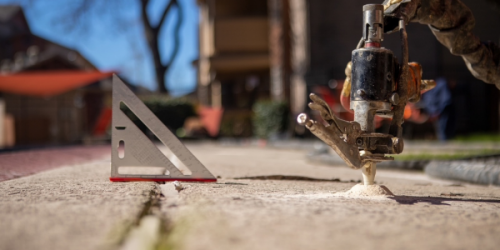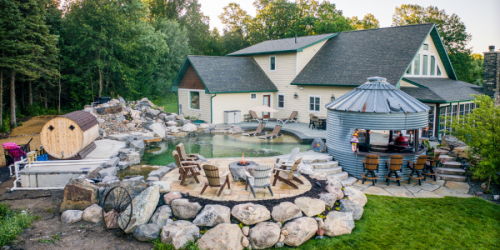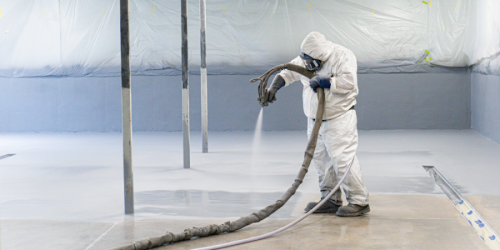Q&A Forums
Foam question Post New Topic | Post Reply
| Author | Comments |
|---|---|
|
Bryan Kwater
Posted: Feb 28, 2011 10:58 PM
|
Foam question
If I am not mistaken, closed cell foam is >90% closed cells. What percentage of closed cells is typically in open cell foam such as .5 pound or 1.0 pound? Also, is there a benefit to having more open cells in a foam? How about for sound absorbing? |
|
jimcoler
I have over 10 years of experience specifying and installing open and closed cell spray foam. I've sold my business but I'm still selling for the new owners and consulting on large and custom specific jobs. I've expanded my knowledge into t Posted: Mar 01, 2011 06:25 AM
|
You are correct! The way it was explained to me, is each cell has 13 sides to it and on;y 1 side is cracked open in closed cell and 3 sides cracked open in open cell! Tha's the difference!So, I don't see much difference in the products except that the closed cell is much more expensive/R-value and much more inflexible. Wood is also an open cell. So why would you want to spray a closed cell product in an open cell cavity? But then again, it is only partially closed cell with at least 1 side cracked open! Clsoed cell will still absorb water but when it does, it doesn't let it out. That's one of the biggest differences between open and closed cell. Jim |
|
Jeremy Slosek
Posted: Mar 01, 2011 06:54 AM
|
Well we have been in business for ten years and Closed Cell is 90% of our business. We have found this to be the superior product. I think maybe the info that some people get is misleading. |
|
steven argus
Posted: Mar 01, 2011 09:51 AM
|
Talk to a 2# guy and he's gonna say 2# is the best. Talk to a .5# guy and of course, he will say .5# is the best. All desities of foam have their place. We spray them all and all foams perform better than filterglass or newspaper. To answer your questions, I'm not a chemist nor am I Mason, but I do know that all foams have a certain percentage of closed cell. The higher the desity, the higher the percentage. All foams help to reduce sound transmission but open cell is better at absorbing sound. Hope this helps. |
|
Posted: Mar 01, 2011 10:15 AM
|
repectfully,, and somewhat anecdotally,,, (but remember,,,i work in the land of fruits and nuts,,where you live and die by code,,and icc-es reports,,and coatings only used over the foams they have been specifically tested over,,,and,,) we had a structure with 4" cc foam sidewalls exposed to 7.5foot of flood water for 2 months,, initially,,the city wanted all insulation removed from the walls,,like all the other homes..but,,having confidence in the impermiabliity of our product we requested that they do some core samples and see just how far the water impregnated the foam... well,,long story short(from me?no friggin chance)they saw no penetration/staining into the bun of the foam(yes even the planed/trimmed/shaved foam)...just the mud on the skin ,,,and they power washed it off,,,rewired,,rerocked and went on with life,,, all homes with oc foam had to have it removed as the dirty water was able to work its way into the intertestities of the foam matrix holding the debris much like a sponge... now the water did indeed drain from the oc foam,,,but the effluents remained in the matrix.. sound reduction properties of filterglass and oc are real close in the "numbers"(stc nrc),,what gives oc the boost is its application which obviously would do a better job at sealing the channels that air borne sound travel.,,and 90% or so of sound is air borne,,,the other 10% or so is vibrational,,,which makes cc less attractive for this type of appliction due to its rigidity,,and its propensity to vibrational transmition.,, hate to say it,,,but our builders use filterglass for interior wall sound 95% of the time,,unless we have a theater room or some other "special" application,,, |
|
mason
Posted: Mar 01, 2011 11:11 AM
|
Low density foam averages around 90 percent open cells. It is a better sound absorbing material than closed cell foam due to its less dense structure and open cells. It is not quite as sound absorbent as cellulose of fiberglass. However, because it seals cracks and crevices, it is a more effectively minimizes noise from outside sources than either fiberglass or cellulose. Most of your low density foam manufactures have STC and sound absorbing data from tests that are listed on the data sheets. |
|
Bryan Kwater
Posted: Mar 01, 2011 03:06 PM
|
Thanks for everyone's input. I realize the differences between open and closed cell foams and the densities, I was just wondering if there was a scenario where foam with say 20% closed cells would be better than a foam with 90% closed cells. Nothing important, just something I was thinking about. |
|
mason
Posted: Mar 01, 2011 04:18 PM
|
I didn't mention the "tweener" foams. These have a density of 1 to 1.2 pcf. They typically have between 40 to 60% open cells depending on the formula. I don't have any field performance or sound absorption data on those foams. |
|
Posted: Mar 01, 2011 06:54 PM
|
(probably cause there arent any,,,much like there aren't any icc-es reports on these foams..lol)burp |
|
Dean Nash
Posted: Mar 02, 2011 08:53 AM
|
Found something for you FD: ESR 3034 May I introduce a "tweener" |
|
John Shockney
Posted: Mar 02, 2011 11:06 AM
|
I have tried one of these “tweener” foams a few years ago a 1-1.2 pound water blown closed cell with an R-5 per inch it yielded around 5,000-5,500bdft and cost $2000 per set that puts the R-value per square foot per dollar at R-12.5 to R-13.75 depending on actual yield. A 2pound closed cell at R-6.9 will yield 4,000-4,500bdft and cost $2000 per set that puts the R-value per square foot per dollar at R-13.8 to R-15.53 depending on actual yield. So what is the advantage of these foams? If you are using some of these foams you should crunch the numbers and see if there is an R-value advantage, but I have yet to find one (if they have the testing or not) I have heard that one “want to be manufacture” was buying foam from a major manufacture and adding water and some other chems then relabeling it to make some of this foam but they didn’t last long. Airpro |
|
Posted: Mar 02, 2011 11:20 AM
|
thanx jagster,,, it is good to see a proactive vendor,, doing all it can do to bring a viable product to the market.... THEY have a better chance of US being able to use their products out in the field,, i hope to see more VENDORS takeing the investment in THEIR FUTURE |
|
Dean Nash
Posted: Mar 02, 2011 11:50 AM
|
airpro- It's one of those "price the job & let the needs of the job dictate the product" situations. Not viable in many applications but if you're limited to a certain thickness then a "tweener" might give you the 1-up over someone only bidding with 2#. FTR-its a demilac product private labeled for SP. Verdict is still out on the yield, waiting for you guys to spread the knowledge. Don't peddle any foam here but always want to be in the know. I'm told there is another one pending, Amerifoam or USA foam (???), that'll offer a little higher R-value & probably a little less yield with ICC in the works. |
|
John Shockney
Posted: Mar 02, 2011 12:24 PM
|
Jag It still comes down to how much R-value you are getting for your dollar and how much space you have to put it and ½ pound open cell is still the best value due to the high yield as long as it will fit into the space Airpro |
|
Dean Nash
Posted: Mar 02, 2011 02:35 PM
|
AP- you're dead on but for the sake of argument let's assume the SP800 mentioned above provides a yield of 12-13000bft. An R19 is provided based on the ICC report with 4.25 inches of foam and I'll suggest a delivered cost to your location of 2,050.00/set without tax. At least until the price increase goes into affect on 3/17 **NOTE: nominal density of the product referenced above (SP800/ESR3034) according to the ICC report indicates 0.6-0.8pcf density. The yield referenced above is an educated guess based on the density as I have no further data from the field** Your chemical cost to provide a customer an R19 is 0.16/inch or approximately 0.68/sq.ft. Doing the same math with many of the common OC foams(3.6r), it'll take 5.5 inches for an R19 but you'll have some overspray in the cavity. So we'll figure it at 6 inches @ an average cost for those products based on the same math of 0.14/inch or 0.84/sq.ft. Then you have to trim it, clean it up, bag it, and dispose of it. So, the value for the R is there provided a report is there to back it up and no, we don't sell it. Joe IME |
|
Posted: Mar 02, 2011 04:53 PM
|
boy i think it is dangerous to be talking material costs on a public forum..... no other industry does this!!! it can only lead to major confusion with final markup... what we need,,and what the consumer will "consider" is fair and "reasonable" may indeed be neither,, just a thought |
|
Dean Nash
Posted: Mar 02, 2011 05:27 PM
|
Your quiet reprimand I will accept however, in teaching one to teach; the result can, and most often will, provide another with the ability to sell. |
|
steven argus
Posted: Mar 02, 2011 06:02 PM
|
I also think talking $$$ on this forum is a bad idea. And, are we really gonna use the term "tweener"?? Come on. |
|
quentin
Posted: Mar 02, 2011 08:55 PM
|
Who knows, maybe talking money is a GOOD thing. I have had customers who I flat told the cost of the foam and then the added costs of fuel and the rest and made MORE off them since they know we have to make a living too. If they want to pay the cost of materials and not much more, most likely they are not going to be a customer you want anyways since they will then be going over with that microscope instead. Most people who are the clients you want are those who are interested in fair value and also understand and know you will need fair value for your time, equipment and costs too. I won more than one bid with that honesty against lower priced competition with great customers and avoided some serious problem ones who wanted price from that big company near me doing it for cost and making it all up in overcharging for glass and paper who regret it later with the poor install. |
|
Posted: Mar 02, 2011 10:13 PM
|
nope,,i wont say that |
|
John Shockney
Posted: Mar 02, 2011 11:48 PM
|
Who are we kidding almost all of our customers know how much a set of foam costs because they can search the internet or check EBay all we can market is our expertise, heck if the equipment wasn’t so expensive we would have every homeowner spraying their own houses. Airpro |
|
mason
Posted: Mar 03, 2011 09:01 AM
|
I must confess to starting the term "tweener foams" to describe sprayfoams that are 1 to 1.2 lb density and have closed cell content around 50%. The reason I use tweener is that the physical properties of density, open/closed cell content and compressive strength is almost exactly between the 1/2 lb foam and 2 lb foam, hence the term "tweener" to describe them. I am all for another term that would more accurately describe them. But for now, I think when you refer to a tweener foam, it is pretty clear what we are discussing. |





























